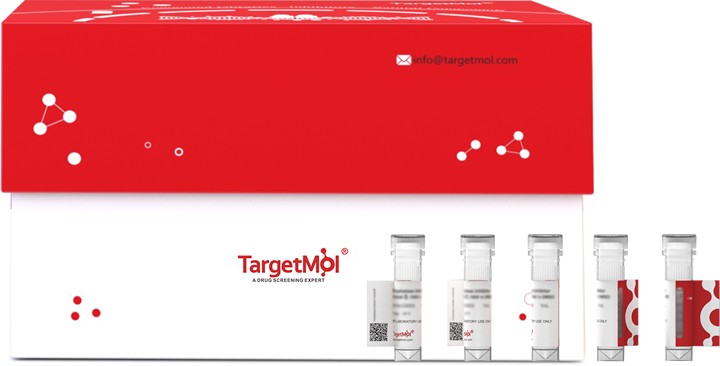- Remove All
 Your shopping cart is currently empty
Your shopping cart is currently empty
Cystatin B Protein, Human, Recombinant (His)
Cystatin-B, also known as CPI-B, Liver thiol proteinase inhibitor, Stefin-B, CSTB and CST6, is a cytoplasm and nucleus protein which belongs to thecystatin family. Cystatin-B / CSTB is an intracellular thiol proteinase inhibitor. Tightly binding reversible inhibitor of cathepsins L, H and B. Cystatin-B / CSTB is able to form a dimer stabilized by noncovalent forces, inhibiting papain and cathepsins l, h and b. Cystatin-B / CSTB is also thought to play a role in protecting against the proteases leaking from lysosomes. Defects in Cystatin-B / CSTB are the cause of progressive myoclonic epilepsy type 1 (EPM1) which is an autosomal recessive disorder characterized by severe, stimulus-sensitive myoclonus and tonic-clonic seizures. The cystatins are a family of cysteine protease inhibitors with homology to chicken cystatin. Cystatins are physiological inhibitors of cysteine proteinases which are widely distributed in human tissues and fluids. Cystatins typically comprise about 115 amino acids, are largely acidic, contain four conserved cysteine residues known to form two disulfide bonds. Cystatins may be glycosylated and / or phosphorylated, with similarity to fetuins, kininogens, stefins, histidine-rich glycoproteins and cystatin-related proteins. Some of the members are active cysteine protease inhibitors, while others have lost or perhaps never acquired inhibitory activity. Cystatins mainly inhibit peptidases belonging to peptidase families C1 (papain family) and C13 (legumain family).

Cystatin B Protein, Human, Recombinant (His)
| Pack Size | Price | Availability | Quantity |
|---|---|---|---|
| 100 μg | $600 | In Stock |
Product Information
| Biological Activity | Measured by its ability to inhibit papain cleavage of a fluorogenic peptide substrate Z-FR-AMC. The IC50 value is < 30 nM. |
| Description | Cystatin-B, also known as CPI-B, Liver thiol proteinase inhibitor, Stefin-B, CSTB and CST6, is a cytoplasm and nucleus protein which belongs to thecystatin family. Cystatin-B / CSTB is an intracellular thiol proteinase inhibitor. Tightly binding reversible inhibitor of cathepsins L, H and B. Cystatin-B / CSTB is able to form a dimer stabilized by noncovalent forces, inhibiting papain and cathepsins l, h and b. Cystatin-B / CSTB is also thought to play a role in protecting against the proteases leaking from lysosomes. Defects in Cystatin-B / CSTB are the cause of progressive myoclonic epilepsy type 1 (EPM1) which is an autosomal recessive disorder characterized by severe, stimulus-sensitive myoclonus and tonic-clonic seizures. The cystatins are a family of cysteine protease inhibitors with homology to chicken cystatin. Cystatins are physiological inhibitors of cysteine proteinases which are widely distributed in human tissues and fluids. Cystatins typically comprise about 115 amino acids, are largely acidic, contain four conserved cysteine residues known to form two disulfide bonds. Cystatins may be glycosylated and / or phosphorylated, with similarity to fetuins, kininogens, stefins, histidine-rich glycoproteins and cystatin-related proteins. Some of the members are active cysteine protease inhibitors, while others have lost or perhaps never acquired inhibitory activity. Cystatins mainly inhibit peptidases belonging to peptidase families C1 (papain family) and C13 (legumain family). |
| Species | Human |
| Expression System | E. coli |
| Tag | N-His |
| Accession Number | P04080 |
| Synonyms | ULD,STFB,PME,EPM1A,EPM1,cystatin B (stefin B),CST6 |
| Construction | A DNA sequence encoding the human CSTB (P04080) (Met 2-Phe 98) was expressed, with a polyhistide tag at the N-terminus. Predicted N terminal: Met |
| Protein Purity | > 95 % as determined by SDS-PAGE |
| Molecular Weight | 12.5 kDa (predicted); 15 kDa (reducing conditions) |
| Endotoxin | Please contact us for more information. |
| Formulation | Lyophilized from a solution filtered through a 0.22 μm filter, containing 50 mM Tris, 50 mM NaCl, pH 8.0.Typically, a mixture containing 5% to 8% trehalose, mannitol, and 0.01% Tween 80 is incorporated as a protective agent before lyophilization. |
| Reconstitution | A Certificate of Analysis (CoA) containing reconstitution instructions is included with the products. Please refer to the CoA for detailed information. |
| Stability & Storage | It is recommended to store recombinant proteins at -20°C to -80°C for future use. Lyophilized powders can be stably stored for over 12 months, while liquid products can be stored for 6-12 months at -80°C. For reconstituted protein solutions, the solution can be stored at -20°C to -80°C for at least 3 months. Please avoid multiple freeze-thaw cycles and store products in aliquots. |
| Shipping | In general, Lyophilized powders are shipping with blue ice. |
| Research Background | Cystatin-B, also known as CPI-B, Liver thiol proteinase inhibitor, Stefin-B, CSTB and CST6, is a cytoplasm and nucleus protein which belongs to thecystatin family. Cystatin-B / CSTB is an intracellular thiol proteinase inhibitor. Tightly binding reversible inhibitor of cathepsins L, H and B. Cystatin-B / CSTB is able to form a dimer stabilized by noncovalent forces, inhibiting papain and cathepsins l, h and b. Cystatin-B / CSTB is also thought to play a role in protecting against the proteases leaking from lysosomes. Defects in Cystatin-B / CSTB are the cause of progressive myoclonic epilepsy type 1 (EPM1) which is an autosomal recessive disorder characterized by severe, stimulus-sensitive myoclonus and tonic-clonic seizures. The cystatins are a family of cysteine protease inhibitors with homology to chicken cystatin. Cystatins are physiological inhibitors of cysteine proteinases which are widely distributed in human tissues and fluids. Cystatins typically comprise about 115 amino acids, are largely acidic, contain four conserved cysteine residues known to form two disulfide bonds. Cystatins may be glycosylated and / or phosphorylated, with similarity to fetuins, kininogens, stefins, histidine-rich glycoproteins and cystatin-related proteins. Some of the members are active cysteine protease inhibitors, while others have lost or perhaps never acquired inhibitory activity. Cystatins mainly inhibit peptidases belonging to peptidase families C1 (papain family) and C13 (legumain family). |
Dose Conversion
Sci Citations
Calculator
Tech Support

Copyright © 2015-2025 TargetMol Chemicals Inc. All Rights Reserved.


